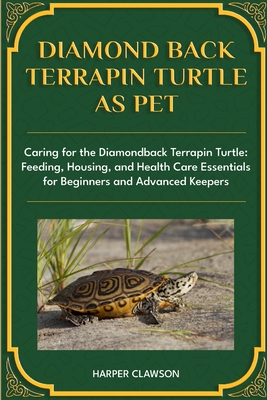Diamondback Terrapin Turtle as Pet: Caring for the Diamondback Terrapin Turtle: Feeding, Housing, and Health Care Essentials for Beginners and Advance

Diamondback Terrapin Turtle as Pet: Caring for the Diamondback Terrapin Turtle: Feeding, Housing, and Health Care Essentials for Beginners and Advance
In the wild, Diamondback Terrapins inhabit coastal marshes, tidal flats, and the muddy shores of estuaries. These environments offer a combination of saltwater and freshwater, allowing the terrapins to thrive in brackish water. The turtles are excellent swimmers but also require basking areas, such as logs or rocks, to dry off and regulate their body temperature.
Physical Characteristics and Unique Traits
Diamondback Terrapins are medium-sized turtles, with adult females reaching up to 10 inches in length, while males typically remain smaller. Their shells are the most notable feature, displaying a unique pattern of overlapping scutes that resemble diamonds. The coloration of their shells ranges from grayish-blue to light brown, and they exhibit distinct markings on their faces, which vary by subspecies.
One of the most striking features of the Diamondback Terrapin is their adaptability to various salinities. This trait allows them to live in both fresh and brackish waters, unlike many other turtles that are confined to one type of environment. Their webbed feet, powerful claws, and sharp beaks make them adept at catching prey in their watery homes.
Natural Environment and Adaptability to Captivity
While the Diamondback Terrapin's natural habitat consists of tidal zones, they are relatively adaptable to captivity when provided with the right environment. In the wild, these turtles are known to be highly territorial and may exhibit some aggression toward other turtles of the same species. In captivity, however, with proper housing, social structure, and enough space, they can live harmoniously with other turtles.
Captive care for Diamondback Terrapins requires a balance of both aquatic and terrestrial environments. These turtles thrive in tanks or outdoor enclosures that allow them access to both water for swimming and a dry basking area for resting. The importance of a well-maintained, clean h
PRP: 116.25 Lei
Acesta este Prețul Recomandat de Producător. Prețul de vânzare al produsului este afișat mai jos.
93.00Lei
93.00Lei
116.25 LeiLivrare in 2-4 saptamani
Descrierea produsului
In the wild, Diamondback Terrapins inhabit coastal marshes, tidal flats, and the muddy shores of estuaries. These environments offer a combination of saltwater and freshwater, allowing the terrapins to thrive in brackish water. The turtles are excellent swimmers but also require basking areas, such as logs or rocks, to dry off and regulate their body temperature.
Physical Characteristics and Unique Traits
Diamondback Terrapins are medium-sized turtles, with adult females reaching up to 10 inches in length, while males typically remain smaller. Their shells are the most notable feature, displaying a unique pattern of overlapping scutes that resemble diamonds. The coloration of their shells ranges from grayish-blue to light brown, and they exhibit distinct markings on their faces, which vary by subspecies.
One of the most striking features of the Diamondback Terrapin is their adaptability to various salinities. This trait allows them to live in both fresh and brackish waters, unlike many other turtles that are confined to one type of environment. Their webbed feet, powerful claws, and sharp beaks make them adept at catching prey in their watery homes.
Natural Environment and Adaptability to Captivity
While the Diamondback Terrapin's natural habitat consists of tidal zones, they are relatively adaptable to captivity when provided with the right environment. In the wild, these turtles are known to be highly territorial and may exhibit some aggression toward other turtles of the same species. In captivity, however, with proper housing, social structure, and enough space, they can live harmoniously with other turtles.
Captive care for Diamondback Terrapins requires a balance of both aquatic and terrestrial environments. These turtles thrive in tanks or outdoor enclosures that allow them access to both water for swimming and a dry basking area for resting. The importance of a well-maintained, clean h
Detaliile produsului










